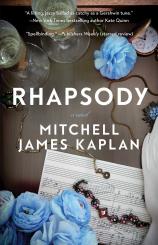Rhapsody
Review
Rhapsody
George Gershwin will go down in history as one of the great American composers and musicians of the 20th century. Concert hall music was the domain of soloists and orchestras performing the great European composers --- orchestral and operatic performances by Beethoven, Chopin, Mozart and Debussy, along with Wagner, Liszt and Verdi.
RHAPSODY is a story about the brief romance between Gershwin and the beautiful and remarkable young pianist, Katharine “Kay” Swift, who contributed so much to American music. The storyline also hints of women’s voting rights, Prohibition, the Wall Street Crash of 1929 and the Great Depression. But that was yet to come. The Roaring Twenties were up and running.
Kay was schooled in the customary style of composition. Her father, the owner of a factory in New Haven, respected the traditional music of his European roots and invested in a piano to encourage her budding musical talent by seeing that she received training from a young age. This led her to form a female salon trio of piano, cello and violin, which became in demand at the fashionable soirées of the time, held in the luxurious townhouses of Manhattan’s millionaires. It was there that she would meet and be wooed by --- and eventually marry --- James Warburg, the son of Wall Street investment tycoon Paul Warburg.
"The novel flows as lyrically through Kaplan’s prose as the wail of the saxophones and crescendos of Gershwin’s keyboards."
Gershwin was an unknown name among the soirée circle. Kay had learned through New York Philharmonic leader Paul Whiteman that Gershwin was set to perform a piece of “new music --- terribly innovative and exciting” at the Aeolian Hall, promoted as Rhapsody in Blue. The New York Times brushed it off as experimental and noisy. But Kay was captivated by its rhythms and chord constructions, and became what today would be called a fan. Gershwin’s genius would swing us into the Jazz Age with a new style of music that would joyously sweep through America following the Spanish flu pandemic and what was then believed to be the Last Great War. Kay wanted to meet this musical genius.
Thus begins the saga of two star-crossed lovers at the very birth of the Jazz Age that moved from South Carolina’s Gullah Island to Upper West Side speakeasies, Broadway and eventually movie screens. Mitchell James Kaplan writes this book in a style that may differ from other historical novelists. He points out that some write intimate novels that just happen to be set in the past, while others produce epics. He believes that the historical novel seeks to fill in gaps in the historical record, perhaps putting more emphasis on subjective human experience, dialogue and thoughts. He observes that some writers place a premium on entertainment value, others on authenticity, and still others on style. He feels that all of these aspects are interconnected and considers it his obligation to value them equally. RHAPSODY does it all.
The novel flows as lyrically through Kaplan’s prose as the wail of the saxophones and crescendos of Gershwin’s keyboards. You can almost hear the taxi horns and clopping hooves of carriage horses in Central Park through his words as you imagine riding down Park Avenue past the towering edifices of lush mansions. As Kay becomes so absorbed in her performing as to be swept away from her audience, I read this book under that same captivation as minutes flowed into hours. Only my noisy team of hungry terriers could break my concentration.
Having grown up in the mid-20th century, I must have seen or listened to every musical influenced by Gershwin’s genius --- all of the recordings, plays and movie scores that I could afford. His influence flowed through many of Fred Astaire and Ginger Rogers’ movies. He and Kay Swift wrote Porgy and Bess and were the inspiration for An American in Paris. Sadly his work was brought to a sudden and tragic end at age 38 from a brain tumor. But Kay would be at the center of what would blossom into American popular music, bringing everyday people to visit stages, concert halls and movie theaters of the new era.
Reviewed by Roz Shea on March 12, 2021
Rhapsody
- Publication Date: December 7, 2021
- Genres: Fiction, Historical Fiction
- Paperback: 352 pages
- Publisher: Gallery Books
- ISBN-10: 1982104015
- ISBN-13: 9781982104016




